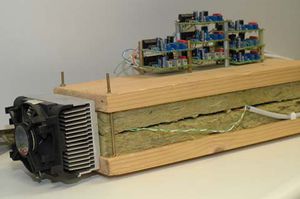Difference between revisions of "Thermal Conductivity of Metals"
(Texto inicial (falta o protocolo avançado)) |
(Continuação do texto) |
||
| Line 28: | Line 28: | ||
'''Note:''' The heat sink keeps the ends of the bars at room temperature, which means that the readings of one of the thermometers will not vary, having been chosen as the reference point for distance. | '''Note:''' The heat sink keeps the ends of the bars at room temperature, which means that the readings of one of the thermometers will not vary, having been chosen as the reference point for distance. | ||
| + | |||
| + | |||
| + | =Advanced Protocol= | ||
| + | In pulsed mode, the temperature reading has two components: | ||
| + | |||
| + | # one comes from the oscillation of the heating itself, its period being the same as the heat source (on and off); | ||
| + | # the other is the average heating of the bar as a whole, which is almost exponential. | ||
| + | |||
| + | Through a graphical fitting of a function to the average temperature, we can extract the oscillating values by subtracting the average. By analyzing the oscillating data, we can determine the heat propagation constant by Fourier analysis or a simple sinusoidal fitting. | ||
| + | |||
| + | For best results, please follow the procedure: | ||
| + | |||
| + | # Execute two experiments in pulsed mode, selecting an interval of a few seconds between samples and a heating about a minute. In the first run, choose the maximum possible recording time and, after looking at these, do the second with a recording time depending on the results of the first; | ||
| + | # Copy to the data to a spreadsheet or a science application, like Matlab or Origin; | ||
| + | # Fit a math function to the thermal behavior of the bar; | ||
| + | # | ||
| + | # | ||
| + | # | ||
Revision as of 18:30, 23 May 2012
UNDER CONSTRUCTION
Description of the Experiment
This experiment revolves around the conduction of heat. The user can study and compare how fast heat propagates through three bars of different materials.
<swf height="200" width="500">http://www.elab.tecnico.ulisboa.pt/anexos/descricoes-flash/ConducaoCalorFinal.swf</swf>
Experimental Apparatus
Two methods are used to study heat conduction through metals:
- Single thermal pulse, applied to both ends, and subsequent evolution through the three monitored points;
- Comparison of the output of each bar's first sensor.
Each bar has a 5mm diameter and 370mm length, and the three metals are iron, copper and brass.
The first 70mm of each bar have a heating resistor wrapped around them. 10mm away from the heat sink is the first batch of thermometers, the second being at 250mm and the third at 300. The heat sink keeps of of the ends at room temperature and is the reference point for the position axis. The bars are mounted in the middle of two 50mm thick layers of thermal insulation (rockwool) prevent heat convection and minimize thermal losses.
An electric current is applied to the heating resistor and this heats that end (through Joule's effect). The heating regime can be pulsed or periodic. The heat generated will run through the bar and be dissipated at the opposite end, with the sink.
By choosing the pulse width (it should be around one minute), heat propagation can be observed by measuring the three points described earlier.
Protocol
Run the experiment in pulse mode and observe how the pulse travels along the bars.
Note: The heat sink keeps the ends of the bars at room temperature, which means that the readings of one of the thermometers will not vary, having been chosen as the reference point for distance.
Advanced Protocol
In pulsed mode, the temperature reading has two components:
- one comes from the oscillation of the heating itself, its period being the same as the heat source (on and off);
- the other is the average heating of the bar as a whole, which is almost exponential.
Through a graphical fitting of a function to the average temperature, we can extract the oscillating values by subtracting the average. By analyzing the oscillating data, we can determine the heat propagation constant by Fourier analysis or a simple sinusoidal fitting.
For best results, please follow the procedure:
- Execute two experiments in pulsed mode, selecting an interval of a few seconds between samples and a heating about a minute. In the first run, choose the maximum possible recording time and, after looking at these, do the second with a recording time depending on the results of the first;
- Copy to the data to a spreadsheet or a science application, like Matlab or Origin;
- Fit a math function to the thermal behavior of the bar;
